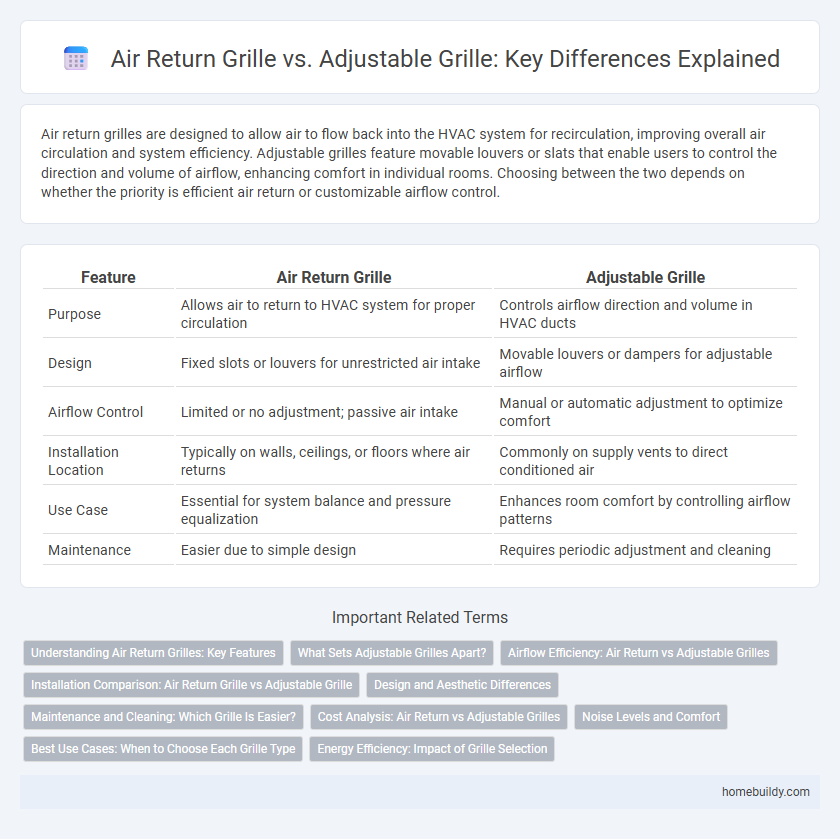Air return grilles are designed to allow air to flow back into the HVAC system for recirculation, improving overall air circulation and system efficiency. Adjustable grilles feature movable louvers or slats that enable users to control the direction and volume of airflow, enhancing comfort in individual rooms. Choosing between the two depends on whether the priority is efficient air return or customizable airflow control.
Table of Comparison
| Feature | Air Return Grille | Adjustable Grille |
|---|---|---|
| Purpose | Allows air to return to HVAC system for proper circulation | Controls airflow direction and volume in HVAC ducts |
| Design | Fixed slots or louvers for unrestricted air intake | Movable louvers or dampers for adjustable airflow |
| Airflow Control | Limited or no adjustment; passive air intake | Manual or automatic adjustment to optimize comfort |
| Installation Location | Typically on walls, ceilings, or floors where air returns | Commonly on supply vents to direct conditioned air |
| Use Case | Essential for system balance and pressure equalization | Enhances room comfort by controlling airflow patterns |
| Maintenance | Easier due to simple design | Requires periodic adjustment and cleaning |
Understanding Air Return Grilles: Key Features
Air return grilles are designed primarily to allow air to flow back into HVAC systems while filtering out debris and maintaining system efficiency. Adjustable grilles offer flexibility by enabling users to control airflow direction and volume, enhancing comfort in various spaces. Key features of air return grilles include durable materials, appropriate sizing for optimal air exchange, and integrated filters to improve indoor air quality.
What Sets Adjustable Grilles Apart?
Adjustable grilles distinguish themselves from standard air return grilles by offering customizable airflow direction, enhancing ventilation efficiency and comfort in interior spaces. Their movable louvers allow precise control over air distribution, unlike fixed return grilles that primarily facilitate air intake without airflow modulation. This versatility makes adjustable grilles ideal for optimizing HVAC system performance and adapting to varying environmental needs.
Airflow Efficiency: Air Return vs Adjustable Grilles
Air return grilles are specifically designed to maximize airflow efficiency by facilitating smooth, unrestricted air circulation back to the HVAC system, minimizing pressure drop and enhancing overall system performance. Adjustable grilles offer flexibility in directing airflow but can create turbulence and resistance, which may reduce airflow efficiency compared to fixed air return grilles. Optimizing airflow with air return grilles ensures balanced ventilation and improved energy efficiency in heating and cooling applications.
Installation Comparison: Air Return Grille vs Adjustable Grille
Air return grilles typically require straightforward installation, often mounted directly onto the wall or ceiling with screws into pre-existing duct openings, ensuring efficient airflow return in HVAC systems. Adjustable grilles demand a more precise installation process to accommodate movable louvers or dampers, allowing customized airflow direction and volume control. The complexity of installing adjustable grilles can involve additional steps such as aligning mechanisms and sealing movable parts to maintain system efficiency and prevent air leakage.
Design and Aesthetic Differences
Air return grilles are typically designed with larger, fixed louvers to maximize airflow return while maintaining a minimal visual impact, often featuring simple, uniform patterns that blend seamlessly into ceilings or walls. Adjustable grilles incorporate movable louvers or dampers, allowing users to control airflow direction and volume, which adds a functional, dynamic aesthetic element with more intricate designs. The design emphasis for air return grilles prioritizes discreet integration and efficiency, whereas adjustable grilles balance utility and visual prominence, offering greater customization for interior decor.
Maintenance and Cleaning: Which Grille Is Easier?
Air return grilles typically feature a simpler design with fewer moving parts, making them easier to clean and maintain compared to adjustable grilles, which contain louvers and mechanisms that can accumulate dust and require more detailed upkeep. Maintenance of adjustable grilles often involves adjusting each louver manually to ensure proper airflow, complicating cleaning processes. Choosing an air return grille reduces time spent on routine cleaning and minimizes the risk of mechanical wear from frequent adjustments.
Cost Analysis: Air Return vs Adjustable Grilles
Air return grilles generally come at a lower upfront cost compared to adjustable grilles, making them a budget-friendly choice for standard HVAC systems. Adjustable grilles, while costlier, provide enhanced airflow control and flexibility, potentially reducing energy consumption and operational costs over time. Evaluating long-term savings versus initial investment is essential for determining the most cost-effective solution for specific ventilation needs.
Noise Levels and Comfort
Air return grilles are designed to facilitate smooth airflow with minimal noise, enhancing comfort in HVAC systems by reducing disruptive sound levels. Adjustable grilles offer flexibility in directing airflow but may generate increased noise when dampers are manipulated or partially closed. Selecting between air return grilles and adjustable grilles directly impacts indoor acoustics and overall thermal comfort, with fixed return grilles typically providing quieter, more consistent airflow.
Best Use Cases: When to Choose Each Grille Type
An air return grille is best suited for HVAC systems requiring consistent airflow and aesthetics integration in return air pathways, typically installed in walls or ceilings. Adjustable grilles provide flexibility for controlling airflow volume and direction, making them ideal for spaces with varying ventilation needs or temperature zones. Choose air return grilles for fixed, efficient air return applications, while adjustable grilles fit dynamic environments demanding customizable airflow.
Energy Efficiency: Impact of Grille Selection
Air return grilles promote energy efficiency by facilitating consistent airflow and reducing pressure drops within HVAC systems, contributing to lower energy consumption. Adjustable grilles offer the ability to tailor airflow distribution, enhancing zone-specific comfort but may introduce variability that impacts overall system efficiency. Selecting the appropriate grille based on HVAC design parameters optimizes energy performance and reduces operational costs.
Air return grille vs Adjustable grille Infographic

 homebuildy.com
homebuildy.com